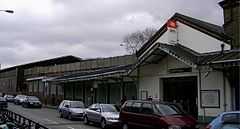Balham station

Balham station consists of two adjacent stations (a London Underground station and a National Rail station) in the Balham area of south London, England. The station is on the A24 Balham High Road in the London Borough of Wandsworth, and is in Travelcard Zone 3.
The two stations are connected, though owned and operated separately with separate ticket-issuing facilities and gatelines.
National Rail station
 | |
 Balham Location of Balham in Greater London | |
| Location | Balham |
| Local authority | Wandsworth |
| Managed by | Southern |
| Station code | BAL |
| Number of platforms | 4 |
| Fare zone | 3 |
| National Rail annual entry and exit | |
| 2007–08 |
|
| 2008–09 |
|
| 2009–10 |
|
| 2010–11 |
|
| 2011-12 |
|
| Original company | London, Brighton and South Coast Railway |
| Pre-grouping | London, Brighton and South Coast Railway |
| Post-grouping | Southern Railway |
| 1863 | Opened as Balham |
| 9 March 1927 | Renamed Balham and Upper Tooting |
| 6 October 1969 | Renamed Balham |
| Lists of stations |
|
| External links | |
|
| |
The National Rail station at Balham, which is managed by Southern, is on the Brighton Main Line, four stops south of London Victoria. Although on a north-south route, the tracks pass through Balham on an approximately east-west axis, with Victoria towards the west.
The tracks are on an embankment and access to the platforms is via an underpass beneath them. There are four tracks and four platforms, although only two are regularly used in service. Just beyond the south/east end of the station, the line divides into two branches. One branch is the Brighton Main Line, continuing towards East Croydon, with the other heading towards Crystal Palace. Further south, there is another branch which heads towards Mitcham Junction and Sutton. Between Balham and Mitcham Junction, a new station at Mitcham Eastfields was opened in 2008.
History

The West End of London and Crystal Palace Railway opened a station named Balham Hill on 1 December 1856,[2] at which time the line ran from Crystal Palace to Wandsworth Common. From the outset the line was worked by the London, Brighton and South Coast Railway, which purchased the line in 1859 after it had been extended to Battersea Wharf. The station was resited by the LB&SCR to its present location in 1863 as part of works to widen the line, and improve the route between East Croydon and Victoria.[3] The new station was named Balham.[2] Further remodelling of the line was undertaken in 1890 and 1897 to increase capacity.[4] It was renamed Balham and Upper Tooting on 9 March 1927, reverting to Balham on 6 October 1969.[2]
The lines through the station to Crystal Palace were electrified in 1910, by means of the LB&SCR 'Elevated Electric' overhead system. Work on electrifing the remaining services through the station had begun in 1913 but was interrupted by the First World War and not completed until 1925.[5] By this time the LB&SCR was absorbed into the Southern Railway following the 1921 Railways Act.
In 1925 the Southern Railway decided to adopt a third rail electrification system and the lines through the station were converted between June 1928 and September 1929.[6]
When sectorisation was introduced in the 1980s, the national rail lines were served by Network SouthEast until the privatisation of the British Railways.
Upon privatisation in the 1990s, the national rail lines came under the Connex South Central franchise, which was replaced by the current operator in 2000.
Services
The typical off-peak service from this station is:
- 12tph (trains per hour) to London Victoria
- 4tph to Sutton
- 3tph to Epsom
- 2tph to Caterham
- 2tph to London Bridge
- 1tph to Epsom Downs
- 1tph to Milton Keynes Central
- 1tph to South Croydon
- The main line station
-

Up Main platform in 1961
-

The view in 1982
London Underground station
 The station entrances | |
| Location | Balham |
| Local authority | Wandsworth |
| Managed by | London Underground |
| Owner | London Underground |
| Number of platforms | 2 |
| Fare zone | 3 |
| London Underground annual entry and exit | |
| 2008 |
|
| 2009 |
|
| 2010 |
|
| Original company | City and South London Railway |
| 13 September 1926 | Line opened |
| 6 December 1926 | Station opened |
| 15 October 1940 | Closed |
| 12 January 1941 | Reopened |
| Lists of stations |
|
|
| |
The station opened on 6 December 1926 as part of the Morden extension of the City & South London Railway (although the line had opened slightly earlier, on 13 September 1926),[10] which later became part of the Northern Line. The station, which is located between Clapham South and Tooting Bec stations, has entrances on the east and west sides of Balham High Road linked by a pedestrian subway. The surface buildings were designed by the architect Charles Holden. It is the only station on the Morden branch of the Northern line directly adjacent to a National Rail station.
World War II

During the Second World War, Balham was one of many deep tube stations designated for use as a civilian air raid shelter. At 20:02 on 14 October 1940, a 1400 kg semi-armour piercing fragmentation bomb fell on the road above the northern end of the platform tunnels, creating a large crater into which a bus then crashed. The northbound platform tunnel partially collapsed and was filled with earth and water from the fractured water mains and sewers above, which also flowed through the cross-passages into the southbound platform tunnel, with the flooding and debris reaching to within 100 yards of Clapham South. According to the Commonwealth War Graves Commission (CWGC), sixty-six people in the station were killed[11] – although some sources report 64 shelterers and 4 railway staff were killed[12] and more than seventy injured. The damage at track level closed the line to traffic between Tooting Bec and Clapham Common, but was quickly repaired, with the closed section and station being reopened on 12 January 1941.[13] In October 2000 a memorial plaque commemorating this event was placed in the station's ticket hall. It stated that 64 lives were lost, which differed from the CWGC register at the time, and other sources. On 14 October 2010 this was replaced with a new commemorative plaque which does not state the number of fatalities.[14]
In popular culture
The video for the single Missing by Everything but the Girl repeatedly uses the same shot from a moving vehicle passing between the two tube entrance buildings, while in another shot Tracey Thorn is seen walking down the side of one of them.
The bombing of the station during World War II is briefly mentioned in Ian McEwan's novel Atonement, while the film based on the book depicts the station's flooding. Both the novel and the film date the event incorrectly, with the novel placing it in September 1940, and the film dating it as 15 October rather than the previous day. The film also refers to the fracturing of gas mains, as well as water.
Transport links
London Bus routes 155, 249, 315, 355 and Night route N155 serve the station.
Gallery
- The underground station
-
Tube station entrance, west side
-
Roundel on northbound Northern line platform
-
Northbound Northern line platform looking north
-

The original memorial plaque, replaced in October 2010
References
- ↑ 1.0 1.1 1.2 1.3 1.4 "Station usage". Rail statistics. Office of Rail Regulation. 30 April 2010. Retrieved 17 January 2011. Please note: Some methodology may vary year on year.
- ↑ 2.0 2.1 2.2 Butt, R.V.J. (1995). The Directory of Railway Stations. Yeovil: Patrick Stephens Ltd. p. 23. ISBN 1-85260-508-1. R508.
- ↑ Turner, John Howard (1978). The London Brighton and South Coast Railway 2 Establishment and Growth. Batsford. pp. 126–129, 238–9. ISBN 0-7134-1198-8.
- ↑ Turner, John Howard (1978). The London Brighton and South Coast Railway 3 Completion and Maturity. Batsford. pp. 81–4, 141–9. ISBN 0-7134-1389-1.
- ↑ Moody, G.T. (1968). Southern Electric 1909-1968=Ian Allan. pp. 7, 23.
- ↑ Moody, (1968) p.25.
- ↑ "Customer metrics: entries and exits: 2008". London Underground performance update. Transport for London. Retrieved 26 December 2012.
- ↑ "Customer metrics: entries and exits: 2009". London Underground performance update. Transport for London. Retrieved 26 December 2012.
- ↑ "Customer metrics: entries and exits: 2010". London Underground performance update. Transport for London. Retrieved 26 December 2012.
- ↑ Rose, Douglas (1999). The London Underground, A Diagrammatic History. Douglas Rose/Capital Transport. ISBN 1-85414-219-4.
- ↑ "Casualty List for Balham". cwgcuser.org.uk. Retrieved 2008-01-21.
- ↑ Croome; Jackson (2003). Rails Through the Clay. Capital. p. 275.
- ↑ "Northern Line, Dates". Clive's Underground Line Guides. Archived from the original on 16 January 2008. Retrieved 2008-01-21.
- ↑ http://www.ukniwm.org.uk/server/show/conMemorial.52421/fromUkniwmSearch/1
External links
| Wikimedia Commons has media related to Balham railway station. |
- Train times and station information for Balham station from National Rail
- London's Transport Museum Photographic Archive
| Preceding station | |
Following station | ||
|---|---|---|---|---|
| Wandsworth Common | Southern South London Line (Outer) London Victoria to Sutton via Crystal Palace |
Streatham Hill | ||
| Southern Sutton & Mole Valley Line (Epsom Branch) West London Line |
Streatham Common | |||
| Southern Sutton & Mole Valley Line (Horsham Branch) |
Mitcham Eastfields | |||
| Preceding station | Following station | |||
towards Morden |
Northern line | |||
| ||||||||||||||||||||||||||||||||||||||||||||||||||
| |||||||||||||||||||||||||||||||||||||||||




